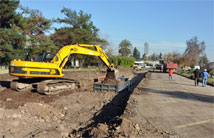Al Wootten

Figure 1. Antenna testing in the 3 contractor camps continued under thin winter clouds at the OSF. On the right, a third antenna has been moved outside the Vertex facility. In the center, the three Melco antennas are being tested. On the left is the AEM camp, where construction of the first European antenna is under way. Photo © Denis Barkats.
 Zoom
Zoom

Figure 2: Excavation has begun on the new Santiago Central Office for the Joint ALMA Observatory, adjacent to the ESO offices in Vitacura. © ALMA (ESO/NAOJ/NRAO)
 Zoom
Zoom
Interferometry at the Operations Support Facility (OSF) with the first two antennas on their 69.7m baseline continued under the guidance of Joint ALMA Office (JAO) personnel after the first dynamic fringes were obtained. Fringes were demonstrated at 1.3mm during the period as instrumental and software tests continued.
A second single baseline correlator, previously used at the Antenna Test Facility on the NRAO VLA site in New Mexico, was updated and delivered to the OSF from the NRAO Central Development Laboratory as preparations there were made to ship the second quadrant of the 64 antenna correlator.
The first of the water vapor radiometers delivered by ESO was deployed for atmospheric water vapor measurements through a window in one of the buildings. Measurement of 0.75 mm of precipitable water vapor on 4 July over the 2900m elevation site suggested observations could be made for the first time in the deep submillimeter Band 9 (0.45 mm). A beam profile of Jupiter was made with both of the first two antennas.
Some astronomical validation tests have now been achieved at the OSF with all four bands installed in the dewar. Total power tests of the third, most recently accepted antenna continued and a third front end dewar was installed for radiometric tests. As this is the first austral winter available for antenna testing, advantage was taken of the cooler night temperatures to investigate surface performance of antennas still in the contractor camps; the next of the twelve antennas in those camps at the site are scheduled to be accepted during August.
Preparations for operations at the 5000m Array Operations Site (AOS) continue. At the NRAO CDL in Charlottesville the first element of the critical Central Local Oscillator (LO) system passed its tests and was shipped to the AOS for installation. Providing reference signals to sixteen antennas, this system is key to multi-antenna interferometry. With 86 foundations now past provisional acceptance at the AOS the critical electrical and fiber optic cable connections from those pads to the AOS Technical Building (TB) have begun. Station 106, near that building, will receive its first antenna for tests soon and is the first to have been connected to the TB.
In Santiago, the JAO has been spread over several buildings, and a lease will soon expire on one. Accordingly, the effort to provide a permanent home adjacent to the ESO offices in nearby Vitacura has proceeded, led by ESO. Preparatory work—the resiting of eleven mature trees elsewhere on the property—has been completed. Early in July, excavation work began for the Santiago Central Office building to house the JAO. The building will include almost 7000 square meters of space on two floors, with underground parking for 130 vehicles. This additional parking allows some surface parking to be restored to green space. Construction is expected to last several years.

 Zoom
Zoom